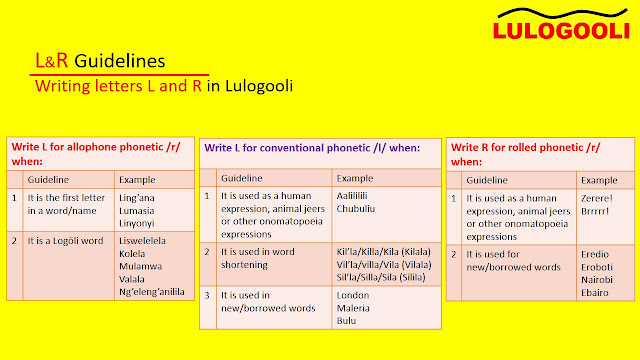Featured
- Get link
- X
- Other Apps
Why we have been writing "L" for Lulogooli and not "R" for Rurogoori.
 |
| Table guide for Lulogooli's phoneme 'l' and 'r' |
The traditional Logooli orthography is courtesy of Quaker Mission that put the first sounds in print early 1900. This must have been informed by the local’s awareness of their language sounds and a contribution of the missionaries as there were already akin letters as of Kiswahili and Luganda. These first writings found the community with great interest to read and write; quickly learning and propagating the language so.
One of the most contested orthography letters is the use of L over R in sounds thought to be more /r/ than /l/. It also confuses a number to separate between short sound /l/ and long sound /l:/. This article aims to clarify on the same, looking at phonemes /l/ and /r/ in brief.
In Language Development in Kenya (1974 page 106, Luluhya Experiment), it quotes, ‘The difficulty over l and r was noted. It was suggested that r should represent the rolled sound, while l should represent the other sounds'. Lulogooli’s use of rolled /r/ was left for exaggeration/onomatopoeic instances [e.g Kiravu zererere, Kuuta Kurrrr] where the tongue is held to vibrate at the palate. Otherwise the sound /r/ should come out soft, with the tongue curling to touch the mid-palate and releasing the air swiftly forward like in voicing a hard /l/ [e.g malala, velelelela, lola].
The above characteristic that moves L'logoori to write /l/ is in the shared similarity of articulation. That letter /l/ as of used in English [e.g meal, cool, sailor] can be found by some to read as [/mea’r’/, /coo’r’/, /sai’r’or/] only that /r/ should not be rolled or aimed to be ‘loud’.
By the above, the linguistical term to explain the phenomena is “allophone”. An allophone defined is any of two or more alternative pronunciations for a sound. That Lulogoli’s ‘r’ and ‘l’ are more similar than different. That ‘/l/’ represents the characteristics of soft /r/ [only that /l/ is articulated at front pallate) better (a liquid of) than a rolled /r/ would – hence writing of l. Though some object.
This does not conflict with Lulogooli sound /l/ as it does not have it save for jeers and onomatopoeic expressions [e.g Aalilili! Chubuliu!]. It can therefore be summarized that the two (l&r) are but a single phoneme in Logooli case, orthographically represented as /l/ in former writings and advocated as /r/ in latter day writing. The Logooli alphabet ‘l’ sound is realized in random speech but as a long sound, /l:/, written as (L’L). This is in shortening of L(r)v1+L(r)v2 = (L:)v2 [e.g Malala(marara) = mal’la, Malilila (maririra) = Mal’lila, Veelelela(veererera) = veelel’la].
The presence of writings where both /l/ and /r/ are used [e.g Leero, Viraji, Kirage] is probably due to infusing two dialects as observed among the Luhya languages where L and R letters are present. Secondly, the writing of /r/ after /e/ or /i/ as evidenced in Lulogooli Bible, though not constant [e.g yili, Israeli, kigira] is a kin to Luganda orthography developed early, 1882 where I quote, “The letter r is used after an e or an i/the letter l is used elsewhere. Both letters may be pronounced /l/ or /r/ depending on context”. This application does not sit well with Lulogooli as there exists no difference in articulation of an /r/(l) preceded with vowel /a/ or /o/ or /u/ as said of /e/ or /i/. What it does, on the detriment, is the assertion of a possible rolled ‘r’, hence overlook of a soft one - if not the mixing of both.
This study however should be extended to the proto-Logooli of a near null /r/ sound. A sound that may have been acquired by association with other languages of r roll. Or not.
- Get link
- X
- Other Apps
Comments
Post a Comment